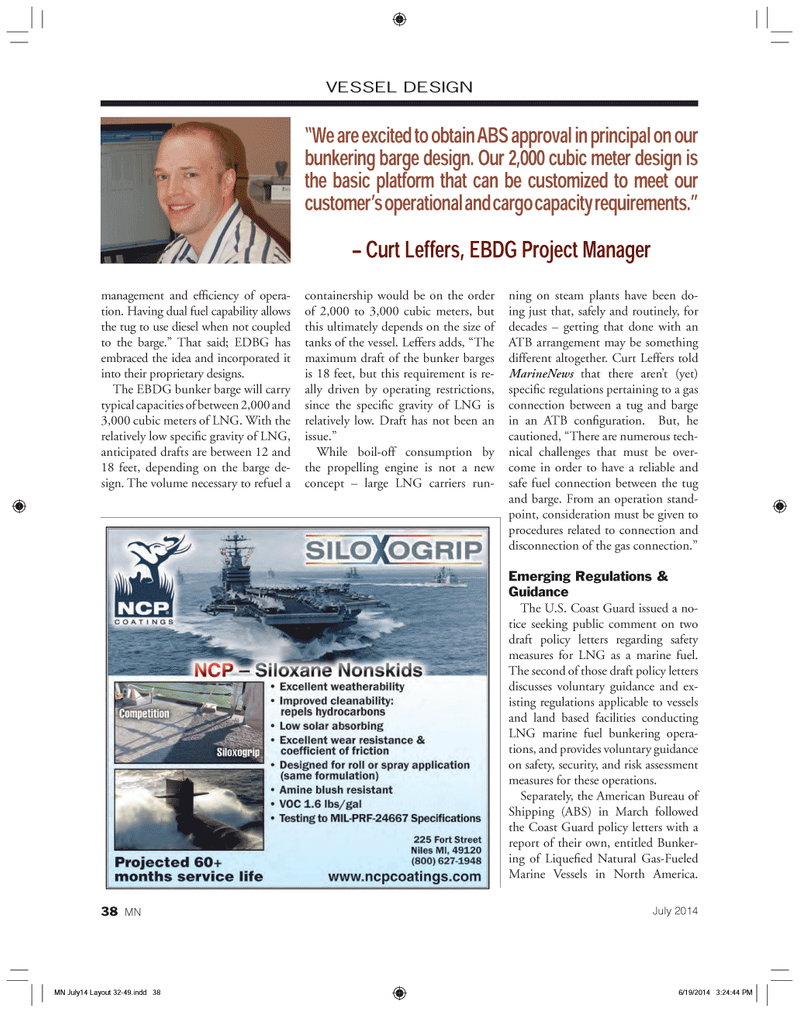
Page 38: of Marine News Magazine (July 2014)
ATB Technical Trends
Read this page in Pdf, Flash or Html5 edition of July 2014 Marine News Magazine
management and efÞ ciency of opera- tion. Having dual fuel capability allows the tug to use diesel when not coupled to the barge.Ó That said; EDBG has embraced the idea and incorporated it into their proprietary designs. The EBDG bunker barge will carry typical capacities of between 2,000 and 3,000 cubic meters of LNG. With the relatively low speciÞ c gravity of LNG, anticipated drafts are between 12 and 18 feet, depending on the barge de-sign. The volume necessary to refuel a containership would be on the order of 2,000 to 3,000 cubic meters, but this ultimately depends on the size of tanks of the vessel. Leffers adds, ÒThe maximum draft of the bunker barges is 18 feet, but this requirement is re- ally driven by operating restrictions, since the speciÞ c gravity of LNG is relatively low. Draft has not been an issue.ÓWhile boil-off consumption by the propelling engine is not a new concept Ð large LNG carriers run- ning on steam plants have been do- ing just that, safely and routinely, for decades Ð getting that done with an ATB arrangement may be something different altogether. Curt Leffers told MarineNews that there arenÕt (yet) speciÞ c regulations pertaining to a gas connection between a tug and barge in an ATB conÞ guration. But, he cautioned, ÒThere are numerous tech- nical challenges that must be over- come in order to have a reliable and safe fuel connection between the tug and barge. From an operation stand- point, consideration must be given to procedures related to connection and disconnection of the gas connection.ÓEmerging Regulations & GuidanceThe U.S. Coast Guard issued a no- tice seeking public comment on two draft policy letters regarding safety measures for LNG as a marine fuel. The second of those draft policy letters discusses voluntary guidance and ex- isting regulations applicable to vessels and land based facilities conducting LNG marine fuel bunkering opera-tions, and provides voluntary guidance on safety, security, and risk assessment measures for these operations. Separately, the American Bureau of Shipping (ABS) in March followed the Coast Guard policy letters with a report of their own, entitled Bunker- ing of LiqueÞ ed Natural Gas-Fueled Marine Vessels in North America. VESSEL DESIGN?We are excited to obtain ABS approval in principal on our bunkering barge design. Our 2,000 cubic meter design is the basic platform that can be customized to meet our customer?s operational and cargo capacity requirements.? ? Curt Leffers, EBDG Project ManagerJuly 201438 MNMN July14 Layout 32-49.indd 38MN July14 Layout 32-49.indd 386/19/2014 3:24:44 PM6/19/2014 3:24:44 PM

 37
37

 39
39
